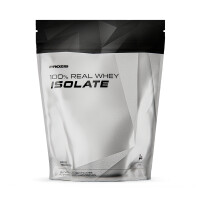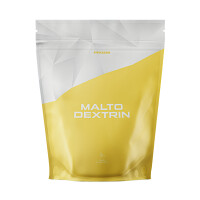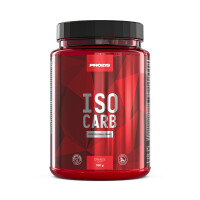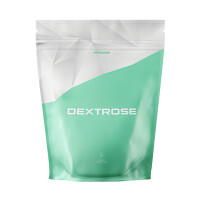
When it comes to building muscle, there are 3 elements athletes must take into account: training, dieting and resting. Training and resting are two topics we already approached in this blog on many occasions. Now, in this article, we will explain the foundations of the muscle building process, also known as bulking.
In fact, food is often overlooked by many bodybuilders, especially beginners. But the harsh truth is that, without the proper nutrients, training will produce no significant results.
If you don’t adapt your diet to your needs, it would be as if you were working on building a house, but had no bricks to build it with. Your house would never take shape. The same happens with our body. This article will give you tips on how to put together an appropriate diet to promote muscle growth.
First step – Calculate your daily calorie intake
Walking, running, writing, talking and whatnot, for any activity you do, you need energy. The body gets that energy from calories, the energy provided by food. In order to gain weight, the body needs more calories than the ones it needs to perform its daily tasks. The body needs a caloric surplus.
One of the most widely used formulas to establish each person’s required calorie intake, considering one’s physical attributes and lifestyle, is the Harris-Benedict equation (1984). First, we need to estimate the basal metabolic rate, which is the amount of energy spent during resting periods (while sleeping, for example).
Men: BMR (kcal) = (13.4 x WEIGHT) + (4.8 x HEIGHT) – (5.68 x AGE) + 88.36
Women: BMR (kcal) = (9.25 x WEIGHT) + (3.1 x HEIGHT) – (4.33 x AGE) + 447.6
With our case study being a male subject, 20 years old, 60 kg and 180 cm tall, we get this result: (13.4×60) + (4.8×180) – (5.68×20) + 88.36 = 1642.76
A female subject with similar physical features would get the following result: (9.25×60) + (3.1×180) – (4.33×20) + 447.6 =1474
Since these values don’t consider one’s physical activity level, we need to add this factor. The following values are consensually accepted:
- Sedentary (Little to no exercise) = Multiplies BMR by 1,2
- Lightly Active (Light exercise/1 – 3 days a week) = Multiplies BMR by 1,375
- Moderately Active (Moderate exercise/3 – 5 days a week) = Multiplies BMR by 1,55
- Vigorously Active (Vigorous exercise/ 6 – 7 days a week) = Multiplies BMR by x 1,725
- Extremely Active (Vigorous exercise every day or twice a day) = Multiplies BMR by 1,9
Going back to the above mentioned athletes and assuming that they are both moderately active athletes:
Man→ 1642,76 x 1,55 = 2546,3
Woman→ 1474 x 1,55 = 2284,7
This is the estimated maintenance intake for each individual. Therefore, if they intend to gain weight, they will need to increase the calorie intake to a number above 2546 and 2285, respectively, so that there is a energetic surplus to promote hypertrophy.
How many additional calories should you take?
There is not an automated nor standard answer for this question. The general recommendation is to consume between 500 to 1000 additional calories per day.
One’s genetics must be taken into consideration on this matter. An ectomorph may increase the daily calorie intake up to 1000. An endomorph, on the other hand, should not increase his daily calorie intake in more than 500 calories because he is prone to gain weight.
In short, there are no magical standard answers. Each individual should adapt this math to his reality. If even increasing the calorie intake by 1000 calories, does not result in weight gain, you should increase the daily calorie intake even more.
Second step – Set the portions for macronutrients
Now that we know how to estimate the needed calorie intake to gain muscle, we need to know how to divide our calories into the 3 macronutrients: proteins, carbs and fats.
Protein has a building function. Protein provides amino acids, essential to build muscle, being also responsible for processes such as repairing tissues, form hormones, enzymes, antibodies, among other. Essentially, protein takes part in all processes that entail “building” something. Proteins can also be used as an energy source.
Carbs are solely used for producing energy. Therefore, it is important to ensure we are consuming enough of this macronutrient, to avoid having to resort to protein as an energy source.
Fats, aside from being an important energy source, also play a key role in hormonal production, promoting the well-being of the cardiovascular system, ensuring the proper functioning of several organs, such as the skin, the hair and the eyes, and are absolutely indispensable to carry and absorb liposoluble vitamins.

Proteins: Amounts and sources to include in your diet
According to the American College of Sport Medicine (ACSM), the protein intake for endurance athletes is 1,2 to 1,4g of protein per kg/day and 1,6 to 1,7g for strength athletes.
However, these recommendations are not consensual. Many bodybuilders actually take 2 g of protein for each kg of body weight, to achieve the energetic surplus necessary to gain mass. This is the reference we will be using in this article.
With this in mind, the male athlete in our case study would have to take roughly 120 grams of protein each day. Proteins have an energy value of 4 calories per gram. 120 Grams of protein correspond to 480 calories. Therefore, if the subject is aiming for a 3200 daily caloric intake, he would have to get the remaining 2720 calories from the other two macronutrients.
Protein sources. Not all proteins are created equal. Some proteins are considered to be better because of their higher biological value. The biological value of a given food has to do with to the amount of essential amino acids that food contains.

That is why eggs are one of the best protein sources there is. Eggs contain all the essential amino acids (essential in the sense that the body is unable to synthesize them) in abundant amounts. Other good protein sources include white meat, red meat, fish and milk.
Usually, vegetable proteins have a lower biological value. Soy and legumes (beans, peas, chickpeas and lentils) would be the exceptions here. Nuts, such as walnuts, almonds and pistachios, should also be included in this type of diet, since they are packed with nutrients.
Every meal you have should contain, at least, 20 grams of protein. As someone in the world of bodybuilding used to say “a meal without protein is not a meal”. In our case study, this means that, if the subject makes 6 meals a day, he should be consuming 15 to 20 grams of protein per meal.
Carbs: Amount and sources to include in your diet
As previously mentioned, carbs’ sole function is to provide the body with energy to perform its daily tasks, both for high and low intensity activities. Ensuring we consume this macronutrient in adequate amounts will keep our body from breaking proteins down for energy.
Institutions such as the World Health Organization and the Dietary Guideline for Americans recommend that carbs should compose 55 to 60% of our total energetic consumption. In our male subject’s case study, whose objective is to consume 3200 calories a day, carbs would represent 1760 to 1920 daily calories, which amounts to 440 to 480 grams of carbs.





Just like proteins, some carbohydrates sources are better then others. In this context, the most important factor to consider is the glycemic index (GI). The glycemic index measures the speed and intensity by which carbohydrates raise the blood’s glucose level, when compared against pure glucose.
In general, processed foods – such as cakes, sweets, bread and white pasta – have a higher GI. This means that they are quickly absorbed into the bloodstream. On the one hand, this process gives the body an energy boost. On the other hand, it only lasts for a short period of time. After a few minutes, this energy runs out and the person starts feeling hungry again..
Nonetheless, there are occasions when GI carbs can be useful, like after training. Here, the main priority is to replenish the muscles with glycogen, and this kind of carbs are the best option. In other situations, low GI carbs would probably be the best route to take. They provide sustained flow of energy and will keep you satisfied longer.
Theres is an article from the Harvard Medical School; that takes you to a list of over 100 foods and respective GI.
For example, High GI foods: processed food, white bread, pasta e flour, white rice, sweets, cake, banana, watermelon, marmalade, honey and soda. As for Low GI foods, we have whole wheat pasta, bread and rice, oats, flaxseed, barley, muesli, vegetables, apple, pear and sweet potatoes.

Fats: Amount and sources to include in your diet
Fats are closely linked to muscle mass gains. Forget the myth that says you should avoid fat, because it’s bad for you. As a matter of fact, fat is essential to the organism. The secret is knowing which fats to have, avoiding the ones that are bad for you.
Fat should amount to 20 to 25% of our daily calorie intake (640 to 800 calories, equivalent to 71 to 89 grams of fat, respectively)
When we talk about good fat (unsaturated) we mean poly- and mono-unsaturated fats Foods packed with mono-unsaturated fats: olives, canola, peanut oil, avocados, sesame seeds and nuts (almonds, chestnuts, walnuts and peanuts).

Foods packed with poly-unsaturated fats: oily cold water fishes (salmon, mackerel, tuna), walnuts, avocados, cauliflower, flaxseed, sunflower seeds and oils (corn, soy, sunflower).
Then, there are the so-called “bad fats”, which are saturated and trans fats. Saturated fats are the main cause of high levels of low-density lipoprotein (LDL), known as bad cholesterol, which may lead to cardiac diseases.
Vegetable fats are unsaturated, but they may turn out to be bad for you deep fried, since they contain trans fats, which are responsible for increasing LDL cholesterol and lowering HDL cholesterol, the “good cholesterol”. This fat is capable of clogging the arteries and can be found in processed foods, such as biscuits, crackers, cakes, margarines and, in small amounts, in meat and dairy products.
Avoid consuming fat before and after training, since slows down the digestive process.
Conclusion
All equations and formulas in this article are statistically validated across the globe. However, as we all know, statistics don’t fare well with specific individual cases. Think of what you just read as an indication to guide in the right direction, rather than something that is set in stone.
It is important to bear in mind that there is no such thing as a diet plan suitable for everybody. A specific diet may show some impressive results for one person, and be useless for somebody else. We need to consider other important factors, such as genetics. And, by the same token, are no mandatory nor forbidden foods. There are only foods that are more recommended, or less recommended.
As for the number of meals per day, the best option would be to do 6/7 meals/day, 2/3 hours apart from one another. It is also possible to do fewer meals, but packing more calories in each one. At the end of the day, what really matters is the calories and macronutrients we consume.
All meals should be balanced in terms of macronutrients, including adequate amounts of protein, carbs and fats.
When we talk about consuming 3200 calories/day, we obviously don’t expect the reader to consume precisely 3200 calories. This is merely a reference value, that may vary 100 or 200 calories from one day to the next. You can use the food calorie table we have included in our blog, to help you put together your diet.
As for sports supplementation, even though they are not mandatory, they have the ability to provide you with that extra boost you need to reach your goals. Consider the male subject in our case study. Given the fact that he weights 60 kg, he’s probably not a great fan of large meals.
A high-calorie diet may be hard to keep every single day. This is where supplementation steps in. A whey protein shake is a quick, easy and affordable way to have 20 to 25 grams of high biological value protein, with all the amino acids needed to properly repair your muscles, at any time of the day.
If you need to skip a meal, a gainer may turn out to be the best help you can get, ensuring 1000 to 1500 calories in a single shake. It eating 2 or 3 pieces of fruit a day is something that simply doesn’t fit into your daily schedule, or if you are an extremely active athlete with higher nutritional demands, a multivitamin can be a great option.
To sum up the role supplements play in a diet plan, think of supplements as something that complement your diet, and not something that replaces food. This mindset will enable you to take full advantage of your regular meals and of your supplements alike.
Finally, if you just don’t want, or don’t know how to put together a dietary plan from scratch, you can use one of our diet plans and adapt it to your own personal goals.
Now let’s hit the weights!
Original article and pictures take www.prozis.com site
Комментариев нет:
Отправить комментарий